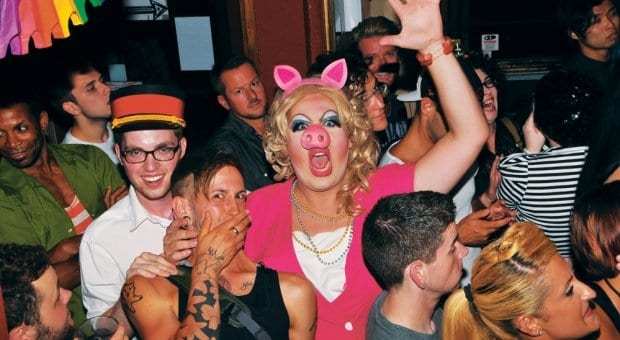Are drag queens sexist? It’s a question that’s been floating around since sensational octogenarian Michelle DuBarry was just a baby queen starting out on a half-century of utter fabulousness. After all, men shrouding themselves with the trappings of exaggerated femininity could be seen by some as mockery or disrespect, but is it possible that drag has evolved into its own performative gender category? Or is it all just good clean fun?
Kevin Nixon has been asking these questions ever since he embarked on his master’s studies several years ago at the University of Waterloo. Now in his fifth year of a PhD with the University of Toronto, Nixon is still digging through the falsies and the wigs to get at the true nature of being a drag queen.
“For my master’s, I was exploring a series on drag queens that had framed performers as sexist gay men appropriating femininity from women,” Nixon says. “I was trying to complicate that perception from a queer theory perspective, getting into how gender and sex are actually social constructs. But I knew that for my PhD I needed to take that research and expand it to a bigger population in a place like Toronto.”
Nixon has studied and interviewed many drag performers for his research and immersed himself in those communities – even taking to the stage himself occasionally to get a taste of life in the world of tuck and heels. “It’s part of the field work that I need to do,” he says. “As a PhD candidate, we’re expected to do at least a year where we participate and observe to try to understand the culture. I mostly participated as an observer, but performing gave me an entirely different perspective.”
So how was it up there, with the lights, the adulation and the testicles crammed into unmentionable places? “I was a completely novice performer,” Nixon laughs. “I was just trying to get my feet wet.
“I was so enthralled with being there to begin with, learning the basics, the look, the transformation, then learning to lip-sync and get over stage fright. These were very basic pantomime performances. I wasn’t going for much of a political element. I just hoped to be a little entertaining.”
Whether overtly stated or bubbling underneath, it’s hard to escape the social politics of a man pretending to be a woman. Some drag performers play it fairly “straight,” doing imitations of Streisand or Whitney while wearing fabulous outfits. Others, like Toronto’s Donnarama, occasionally venture into political commentaries that can border on the explosive, as evidenced by the popular queen’s terrorist-themed performance that caused such a stir this past year.
“I think the goal there is to shake up ideas about identity, queer politics, race and class and gender,” Nixon says. “But there’s a lot of overlap with glamour drag and comedic drag as well. Donnarama is a good example of a queen that straddles all three.”
Race and class are two aspects of drag that Nixon finds particularly fascinating, but he was surprised to find little in the way of anthropological researching taking both aspects into consideration.
“The research often seems to focus on sex, gender and sexuality, rather than taking into account ethno-racial dynamics,” he says. “But my research is more about using drag as a vector to get at some of these questions. How do we feel about race and class in drag? What is drag doing for us as a community, and why do we still consume it so happily? These are all questions that I’m looking at.”
Despite the heady inquiries and endless research, there is still an element of pure enjoyment for Nixon in exploring the world of drag queens. “I was always fascinated by this idea around femininity and gay men,” he says. “When I was coming out, drag became something very interesting to me. The shows seemed magical and exhilarating, and then I was learning about things like the drag aspect of Stonewall and the early days of gay and lesbian liberation. I’m still enthralled by it.”
If you are a drag queen and would like to take part in the study, email Kevin Nixon at dragstudy@gmail.com.

 Why you can trust Xtra
Why you can trust Xtra


